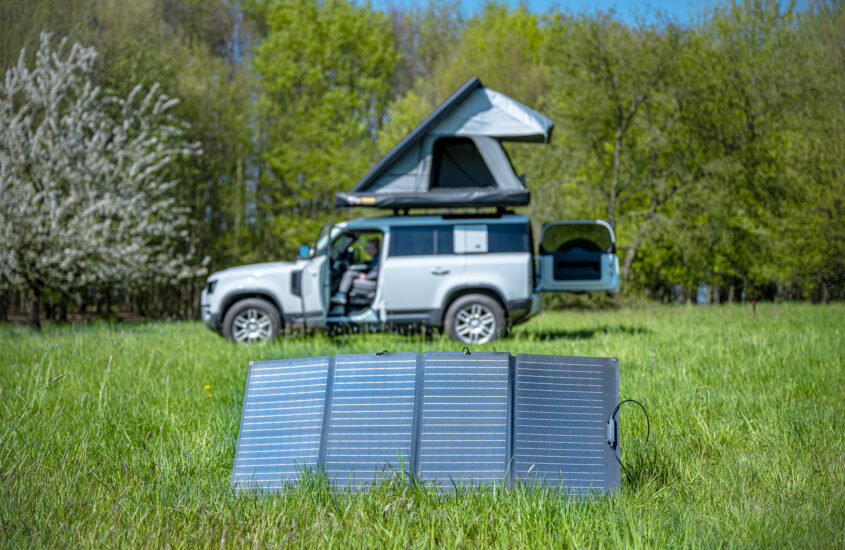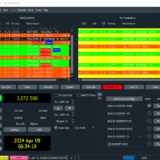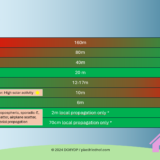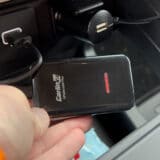Off-road self-sufficient with solar power and battery storage

On the road, we need power for cameras, fridge and other technical equipment. Thanks to the foldable solar panel and lithium-ion powerstation battery with voltage converter, we are self-sufficient.
When we are travelling, we need electricity for various devices. Our cool box needs the most electricity, because it usually cools around the clock. We also charge the batteries of our devices in the evening: Our drone, cameras and other equipment also need electricity.
During the day, the alternator provides enough power for the cool box and also enough power for the smartphone and various batteries. But what happens if we stay somewhere for a longer period of time without the engine running?
There is not only one solution – it’s the mix that counts!
In order to always be somewhat self-sufficient, we want to be able to use the following energy sources:
- 12V from the vehicle’s alternator when the engine is running.
- Solar power when we are “off-grid” somewhere.
- 220V “shore power” where available
- Buffered energy from our lithium-ion battery storage system
This is the only way to ensure that our energy supply is always guaranteed, whether we are driving, standing, whether the sun is shining or not.
In addition, we wanted to use a system that allows simultaneous charging of the storage unit and delivery of electricity to other consumers. In technical jargon, this is called “through-charging”.
Powerstation with solar input and 230V sine converter
At the heart of all our considerations was the EcoFlow RIVER PRO Powerstation with 720 Wh *.
This box stores the energy generated by the vehicle as 12 V current, accepts charging current from solar panels or can also be charged at a normal 230 V socket at the campsite or somewhere in the restaurant. While the box is charging, you can simultaneously power other consumers such as camera batteries, smartphones or even the MacBook – and above all our cool box.
Our Engel M35GP cooler * consumes a maximum of 32 W. During daytime operation, once the box and its contents have cooled down, the energy consumption should be much lower, as the box does not run continuously, but only intermittently. With a storage capacity of 720 Wh and a consumption of 32 W, our cooler should last at least 22.5 hours – in reality even longer.
Keine Produkte gefunden.
The box has two normal 230 V sockets, as we know them from home. The device produces a “clean sine wave”, which means that even sensitive consumers such as laptops can cope with it. Each of the two sockets can supply a device with a maximum consumption of 600 W. This is easily enough for a MacBook. That’s easily enough for a MacBook, iPad, drone and camera batteries. There are enough sockets for them:
- 3 x USB-A (2 x 12 W (5 V; 2.4 A), 1 x 18 W (fast charging))
- 1x USB-C (100 W (5-20 V; 5 A))
- 3 x DC voltage (1x 13.6 V / 10 A / voltage regulated, 2 x DC5521 13.6 V / 3 A)
- 2x AC clean sine wave (230 V / 50 Hz (110 V / 60 Hz) | voltage regulated)
Theoretically, I can use all outputs of the box at the same time to operate or charge devices.
Before we decided on our EcoFlow RIVER PRO Powerstation with 720 Wh * for reasons of price/performance and a good offer, we also had other alternatives on our minds. We have the feeling that the devices all serve their purpose, depending on the requirement. One user needs more connections or capacity, the next needs something completely different. If you are currently on the lookout, also take a look at the PowerDude 500 from Wattstunde * and the Jackery Explorer 1000 *.
Fill up with sun – charging with solar power
Our EcoFlow RIVER PRO Powerstation * can be charged with up to 200W of solar power. In full sunlight, the Powerstation should take 4 hours to charge, but we have not yet been able to test this. When choosing the solar panels, we opted for a space-saving folding system. This is not only easy to stow away, but can also be flexibly oriented towards the sun. Much better than a solar panel permanently installed on the roof, which we had initially preferred.
- 【Tragbar & klappbar】Das EF EcoFlow Solarmodul 160 W ist tragbar, klappbar und kompakt und wiegt nur 15,4 lbs/7 kg. Ob Camping oder...
- 【Intelligente Solarenergie】Das EF EcoFlow Solarmodul 160 W ist darauf ausgelegt, in Kombination mit einer EcoFlow Powerstation...
Again, there were several products to choose from. Ultimately, the devices differ in the number of integrated modules, the IP class for waterproofness and the connection to the power station.
The Jackery SolarSaga 100 * solar panel then lost out to the Ecoflow 160W panel * because the latter offers IP67 protection instead of IP65, delivers 60 W more power due to more panel and comes directly with the MC4 connectors we need.
Ihre Daten werden erst beim Abspielen des Youtube-Videos an den Dienst übermittelt. Your data will only be transmitted to the service when you play the Youtube video.
* Bei allen Links, die mit dem Sternchen markiert sind, handelt es sich um Amazon Affiliate Links. Wir werden prozentual an den darüber getätigten Einkäufen beteiligt. Unsere Empfehlungen sind trotzdem ehrlich und aufrichtig.



